The Great Plains region is generally regarded as homogenous as far as race, religion and sexuality is concerned. And yet, minorities from a variety of backgrounds are present on the Plains, and in many cases that presence is growing. This section identifies several different minorities within the Great Plains, and attempts to give a general overview of their history and contribution to Great Plains culture.
African-Americans in the Great Plains
The Great Plains Black History Museum
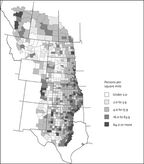
African-American population of the Great Plains, 2000
The Negro Historical Society was founded in 1962 in Omaha, NE, to chronical the African-American experience in the Great Plains through photographs, manuscripts and artifacts. Currently closed to the public, the Great Plains Black History Museum opened in 1976. The items formerly kept in the museum are currently being conserved and inventoried in Lincoln, NE at the Nebraska State Historical Society.
An index of the collections and repositories contained in the Civil Rights History Project is available here .
Slavery and the Great Plains States
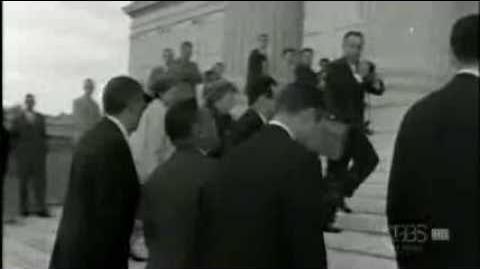
Brown v. Board of Education in PBS' The Supreme Court
Brown v. Board of Education of Topeka lead to the end of discrimination in public schools (PBS)
Civil Rights in the Great Plains
People and events in the Great Plains region proved highly intsrumental in the African-American civil rights movement. In Kansas, particularly, Brown v. The Board of Education of Topeka lead to the desegregation of schools, and African-American youth peacefully protested segregated businesses in the Witchita sit-ins of 1958.
In 1954, the decision of Brown v. The Board of Education of Topeka, comprised of cases from four different states (Kansas, Delaware, South Carolina, Virginia) and the District of Columbia, ended school segregation.[1]
In 1958, two years before the famous Greensboro, NC lunch counter sit-ins, African American students organized a succesful, monthlong sit-in at the Dockum Drugstore in highly segretated Wichita, Kansas. After that month, the busniess the Dockum Drugstore lost from not serving the students forced the owner to begin serving African Americans. [2]
Asian Americans in the Great Plains
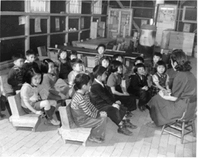
"Story Hour" with Miss Sumi Kashigawi at Grenada Relocation Center.
Camp Amache
The Granada War Relocation Center, or Camp Amache, was a Japanese-American internment camp in the southeastern Colorado town of Granada. Executive Order 9066 lead over 110,000 Americans of Japanese descent to be relocated to various internment camps across the country [3] More than 7000 men, women and children were imprisoned at Camp Amache from 1942-1945[4].
Link to Camp Amache Digital Collection
Link to Camp Amache Records from Colorado State Archives
Hispanic Americans in the Great Plains
While the Great Plains states have recently become heavily populated with Hispanic immigrants--to the point of reviving several small towns across the region, some now comprising fifty percent Hispanic populations [5]--the region has long been home to Hispanic and Hispanic American men, women and children.
In the early 1940s, the United States government implemented the Bracero program, which brought over 4 million migrant workers to work on American farms while American laborers were fighting in WWII. Of course, the Bracero program did by no means introduce the first Hispanic populations to the Great Plains

Satirical Bracero Program comic, from the UFW website
[6], and while the program was terminated in the 1960s, the permanent Hispanic presence has only grown since that time.
Religious Minorities on the Great Plains
In a 2009 study, over 90% of all Americans professed a belief in God or a universal spirit[7]. The majority are Christian--specifically, Lutheran, Catholic, Baptist and Methodist. As of 2000, recorded religious
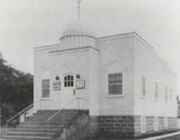
The Mother Mosque in Cedar Rapids, IA
minorities in the Great Plains (overall) included (identified as fewer than 500,000 followers and listed in order from largest to smallest populations) Pentecostals, Presbyterians, Mormons, Assemblies of God, Disciples of Christ, Jews, Independent Noncharismatics, Muslims, Independent Charistmatics, United Church of Christ, Seventh-day Adventists, Baha'i, and Unitarian Universalists. The greatest religious diversity was found to occur in larger cities, including Denver, CO and Oklahoma City, OK, as well as in university towns such as Manhattan, KS. Increasing religous diversity was also found in certain rural areas.[8] Additionally, certain areas of the midwest contain higher concentrations of specific religoius minorities. Illinois, for instance, was in 2010 considered the US state with the highest Muslim population[9], and the Mother Mosque of Cedar Rapids, IA, built in 1934, was the first official mosque in North America. [10]
The LGBTQ Community
The isolated nature of many Great Plains communities, combined with the prevalence of conservative values, has traditionally repressed the outward presence of LGBTQ-identifying individuals in the Great Plains.
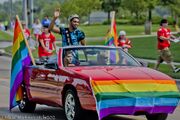
Mr. Gay Omaha 2012 in the Heartland Pride Parade, via Facebook
[11] However, the region has recently made strides towards LGBTQ acceptance and equality. It is now legal for homosexuals to marry in Iowa, Illinois and Colorado allow for civil unions, and Wisconsin legally recognizes "more limited domestic partnership." [12]
Socially, various social events and organizations exist throughout the Great Plains states for expression, entertainment and support. Contestants from each state, including the midwest, compete in the Miss Gay America "female impersonation" pageant. [13] Gay-Straight Alliance groups, which work to educate and promote tolerance and safety between LGBTQ and straight youth in schools, enjoy a increasing presence across the Great Plains states[14] Several gay pride parades, such as the Heartland Pride Parade in Omaha, NE take place across the region annually. [15]
Immigration and the Great Plains
Great Plains Immigration Throughout History Historically, the Great Plains states have encompassed several major "immigrant gateways," or cities with large percentages of foreign immigrants, including Chicago, Minneapolis (a "reemgerging gateway") and, formerly, Cleveland.
Immigration in the 21st Century Though the immigrant population is not as large in Great Plains states as in border and coastal states, the region has seen a rising population, as well as the greatest number of naturalized and Engilsh language-learning immigrants.[16] The percentage of foreign-born men, women and children is only 8% in the midwest; however, the disparity within the reigion is high, with Illinois topping the Great Plains states in foreign-born population, at 14%, and North Dakota ranking 50th. Three of the top ten countires with the fastest-growing immigration populations are located in the midwest. [17] As the largest amount of manufacturing jobs are located in the Great Plains states, the region naturally draws immigrants looking for work opportunities; [18] due to the number of unskilled jobs available, statistically the region generally attracts less educated immigrants (exceptions usually being university cities)[19] "Emerging gateways" in the midwest include Lincoln, NE, Sioux Falls, IA, and Fargo, ND. [20]
- South- and Latin-American Immigrants
Minority Intolerance in the Great Plains
The Ku Klux Klan
While the Ku Klux Klan did not originally have much presence in the Great Plains, by its post-WWI second wave in the 1920s it had gained considerable influence in midwestern states. The Klan preyed on American insecurities over racial and religious minorities following the war, pushing values of "100 percent Americanism" to further its cause. The message was successful; an estimated 20 percent of the entire KKK population functioned within the Great Plains between 1915 and 1944. While Klan membership largely deteriorated after 1925, seeing some revival after WWII and in the 1960s, the group has lost much of the influence it once held in the region.[21]
However, according to the Anti-Defamation League, as of 2013 the Ku Klux Klan, which is becoming increasingly aligned with and indistinguishable to Neo-Nazi or Skinhead groups, has been seeing a resurgence in several Midwestern states. This is in accordance to a national trend, due to the group's exploitation of what the ADL refers to as current "hot-button" issues--such as immigration and gay marriage. [22]
The Omaha (1919) Tulsa (1921) Race Riots
Epitomizing the realities of racial intolerance and KKK influence in the Great Plains, Omaha, NE and Tulsa, OK witnessed two of the worst outbreaks of racial tensions existing in post-WWII America.
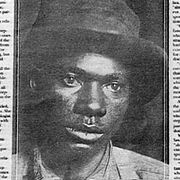
Will Brown, lynched in Omaha in 1919
Throughout the United States, the summer of 1919 saw over 25 race riots. In Omaha on September 25, 41-year-old black man named Will Brown was accused of assaulting a 25-year-old white woman named Agne Loebeck. The Omaha World Herald reported, "Pretty little Agnes Loebeck...was assaulted...by an unidentified negro at twelve o'clock last night, while she was returning to her home in company with Millard [sic] Hoffman, a cripple." An enraged mob, who in their frenzy looted stores for guns and nearly killed Mayor Smith when he attempted to intervene, dragged Brown from his cell in the courthouse. Brown, who maintaned his innocence, was beaten, hanged, shot, dragged, and eventually set on fire. [23]
The Tulsa Race Riots are "believed to be the single worst incident of racial violence in American history."[24] The existing racial tensions of Tulsa, OK, which at the time claimed the second-largest African-American population in the state, came to a head over the course of eighteen hours on May 31st and June 1st, 1921. By the end of the riots, the African-American community of Greenwood had witnessed anywhere from fifty to three hundred deaths, as well the destruction of over a thousand buildings.
References
- ↑ http://www.nps.gov/brvb/historyculture/index.htm
- ↑ http://www.npr.org/templates/story/story.php?storyId=6355095
- ↑ http://plainshumanities.unl.edu/encyclopedia/doc/egp.asam.002
- ↑ http://www.amache.org/
- ↑ http://www.nytimes.com/2011/11/14/us/as-small-towns-wither-on-plains-hispanics-come-to-the-rescue.html?pagewanted=all&_r=0
- ↑ http://memory.loc.gov/ammem/afctshtml/tsme.html
- ↑ http://www.pewforum.org/How-Religious-Is-Your-State-.aspx
- ↑ http://digitalcommons.unl.edu/cgi/viewcontent.cgi?article=1688&context=greatplainsresearch&sei-redir=1&referer=http%3A%2F%2Fwww.google.ie%2Furl%3Fsa%3Dt%26rct%3Dj%26q%3Dreligious%2520minorities%2520great%2520plains%26source%3Dweb%26cd%3D1%26ved%3D0CC8QFjAA%26url%3Dhttp%253A%252F%252Fdigitalcommons.unl.edu%252Fcgi%252Fviewcontent.cgi%253Farticle%253D1688%2526context%253Dgreatplainsresearch%26ei%3DWyxSUYWBHNCMqQHC1oDIDg%26usg%3DAFQjCNFjejBX93o-bpicbmrLCyH6I-Rx_w%26bvm%3Dbv.44342787%2Cd.aWM#search=%22religious%20minorities%20great%20plains%22
- ↑ http://www.huffingtonpost.com/2012/06/27/most-and-least-muslim-states_n_1626144.html
- ↑ http://mothermosque.org/page.php?2
- ↑ http://plainshumanities.unl.edu/encyclopedia/doc/egp.gen.014
- ↑ http://www.freedomtomarry.org/states/
- ↑ http://www.missgayamerica.com
- ↑ http://www.gsanetwork.org/news/blog/movement-building-midwest/12/04/12
- ↑ http://www.heartlandpride.org/
- ↑ http://immigrationtaskforce.hhh.umn.edu/
- ↑ http://immigrationtaskforce.hhh.umn.edu/midwest-summary
- ↑ http://immigrationtaskforce.hhh.umn.edu/
- ↑ http://thesocietypages.org/socimages/2011/07/05/regional-variation-in-educational-levels-of-u-s-immigrants/
- ↑ http://chicago.dpdev.cla.umn.edu/sites/chicago.dpdev.cla.umn.edu/files/Overview%20-%20Final.pdf
- ↑ http://plainshumanities.unl.edu/encyclopedia/doc/egp.pd.031
- ↑ http://archive.adl.org/learn/ext_us/kkk/intro.asp?LEARN_Cat=Extremism&LEARN_SubCat=Extremism_in_America&xpicked=4&item=KKK
- ↑ http://www.nebraskastudies.org/0700/frameset_reset.html?http://www.nebraskastudies.org/0700/stories/0701_0134.html
- ↑ http://digital.library.okstate.edu/encyclopedia/entries/t/tu013.html